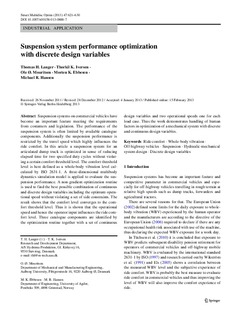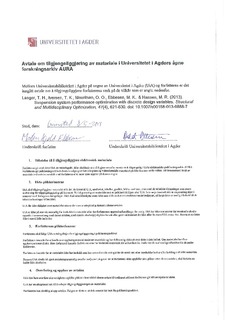| dc.contributor.author | Langer, Thomas H. | |
| dc.contributor.author | Iversen, Thorkil K. | |
| dc.contributor.author | Mouritsen, Ole Ø. | |
| dc.contributor.author | Ebbesen, Morten K. | |
| dc.contributor.author | Hansen, Michael R. | |
| dc.date.accessioned | 2013-04-26T07:30:34Z | |
| dc.date.available | 2013-04-26T07:30:34Z | |
| dc.date.issued | 2013 | |
| dc.identifier.citation | Langer, T. H., Iversen, T. K., Mouritsen, O. O., Ebbesen, M. K., & Hansen, M. R. (2013). Suspension system performance optimization with discrete design variables. Structural and Multidisciplinary Optimization, 47(4), 621-630. doi: 10.1007/s00158-013-0888-7 | no_NO |
| dc.identifier.issn | 1615-147X | |
| dc.identifier.uri | http://hdl.handle.net/11250/136960 | |
| dc.description | Published version of an article in the journal: Structural and Multidisciplinary Optimization. Also available from the publisher at: http://dx.doi.org/10.1007/s00158-013-0888-7 | no_NO |
| dc.description.abstract | Suspension systems on commercial vehicles have become an important feature meeting the requirements from costumers and legislation. The performance of the suspension system is often limited by available catalogue components. Additionally the suspension performance is restricted by the travel speed which highly influences the ride comfort. In this article a suspension system for an articulated dump truck is optimized in sense of reducing elapsed time for two specified duty cycles without violating a certain comfort threshold level. The comfort threshold level is here defined as a whole-body vibration level calculated by ISO 2631-1. A three-dimensional multibody dynamics simulation model is applied to evaluate the suspension performance. A non-gradient optimization routine is used to find the best possible combination of continuous and discrete design variables including the optimum operational speed without violating a set of side constraints. The result shows that the comfort level converges to the comfort threshold level. Thus it is shown that the operational speed and hence the operator input influences the ride comfort level. Three catalogue components are identified by the optimization routine together with a set of continuous design variables and two operational speeds one for each load case. Thus the work demonstrates handling of human factors in optimization of a mechanical system with discrete and continuous design variables. | no_NO |
| dc.language.iso | eng | no_NO |
| dc.publisher | Springer | no_NO |
| dc.subject | ride comfort | no_NO |
| dc.subject | whole-body vibration | no_NO |
| dc.subject | off-highway vehicles | no_NO |
| dc.subject | suspension | no_NO |
| dc.subject | hydraulic-mechanical system design | no_NO |
| dc.subject | discrete design variables | no_NO |
| dc.title | Suspension system performance optimization with discrete design variables | no_NO |
| dc.type | Journal article | no_NO |
| dc.type | Peer reviewed | no_NO |
| dc.subject.nsi | VDP::Technology: 500::Mechanical engineering: 570 | no_NO |
| dc.source.pagenumber | 621-630 | no_NO |
| dc.source.volume | 47 | no_NO |
| dc.source.journal | Structural and Multidisciplinary Optimization | no_NO |
| dc.source.issue | 4 | no_NO |
| dc.identifier.doi | 10.1007/s00158-013-0888-7 | |

